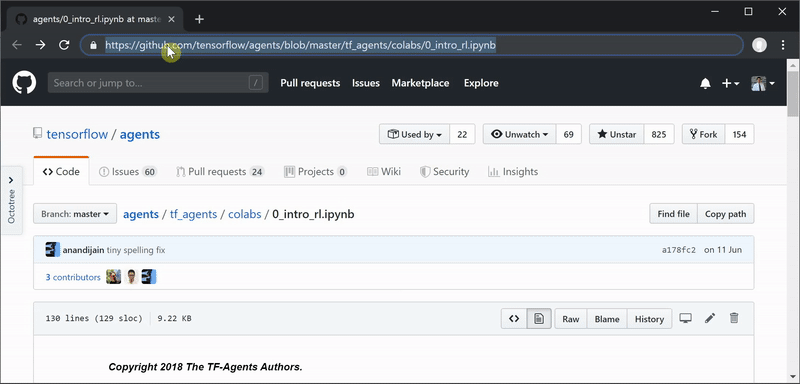How To Use

-
Find the jupyter notebook in GitHub.
github.com/tensorflow/agents/blob/master/tf_agents/colabs/0_intro_rl.ipynb
-
In the link, add
tocolabaftergithub.githubtocolab.com/tensorflow/agents/blob/master/tf_agents/colabs/0_intro_rl.ipynb
-
A Google Colab page with the jupyter notebook will open!
Behind the Scenes
Last week, I read this from the official Colab GitHub Demo:

I thought that it would be lot easier if the link was more memorizable, so I decided to create githubtocolab.com, a simple wepbage that redirects to Google Colab.
I have very little front-end knowledge, so I had to read a lot of tutorials to set it up correctly. Below, I briefly describe what I had to do to and what resources I used.
Purchase Domain and Server
To create a webpage, I needed a domain name and a place to host my website. I purchased the “githubtocolab.com” domain in Namecheap, which was $12 per year. For the place to host my website, I chose DigitalOcean since it had the most tutorials. I chose the smallest “droplet,” which cost $5 a month.
Total cost: $6 per month
DNS Setup: Connect Domain and Server
To Point Namecheap domain to DigitalOcean, I had to setup Nameservers and A Records:

The 142.93.177.234 IP is the DigitalOcean droplet IP.
Here are the three tutorials I read to setup DNS:
- How To Point to DigitalOcean Nameservers From Common Domain Registrars (DigitalOcean)
- How to Add Domains (DigitalOcean)
- How to Create DNS Records (DigitalOcean)
Nginx Setup: Setup Redirects
I set up the server to do two things:
- Redirect “githubtocolab.com” to this blog post.
- Redirect all other (non-root) urls to colaboratory.
server {
root /var/www/githubtocolab.com/html;
index index.html index.htm index.nginx-debian.html;
server_name githubtocolab.com www.githubtocolab.com;
location = / {
return 301 https://endtoend.ai/blog/githubtocolab/;
}
location / {
return 301 https://colab.research.google.com/github/$request_uri;
}
# managed by Certbot
listen [::]:443 ssl ipv6only=on;
listen 443 ssl;
ssl_certificate /etc/letsencrypt/live/githubtocolab.com/fullchain.pem;
ssl_certificate_key /etc/letsencrypt/live/githubtocolab.com/privkey.pem;
include /etc/letsencrypt/options-ssl-nginx.conf;
ssl_dhparam /etc/letsencrypt/ssl-dhparams.pem;
}
server {
# managed by Certbot
if ($host = www.githubtocolab.com) {
return 301 https://$host$request_uri;
}
if ($host = githubtocolab.com) {
return 301 https://$host$request_uri;
}
listen 80;
listen [::]:80;
server_name githubtocolab.com www.githubtocolab.com;
# managed by Certbot
return 404;
}
Here are the four tutorials I read to setup NGINX: